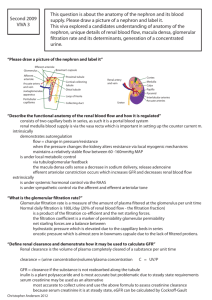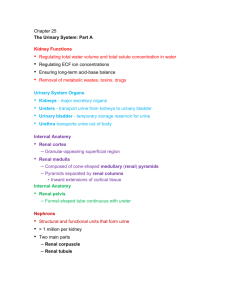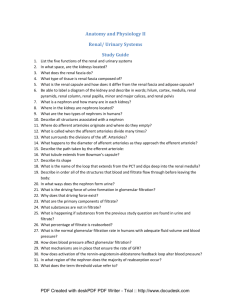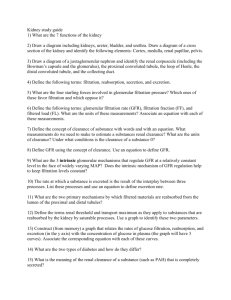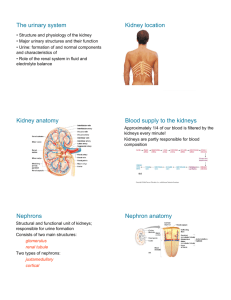chapter 20: urinary system
advertisement
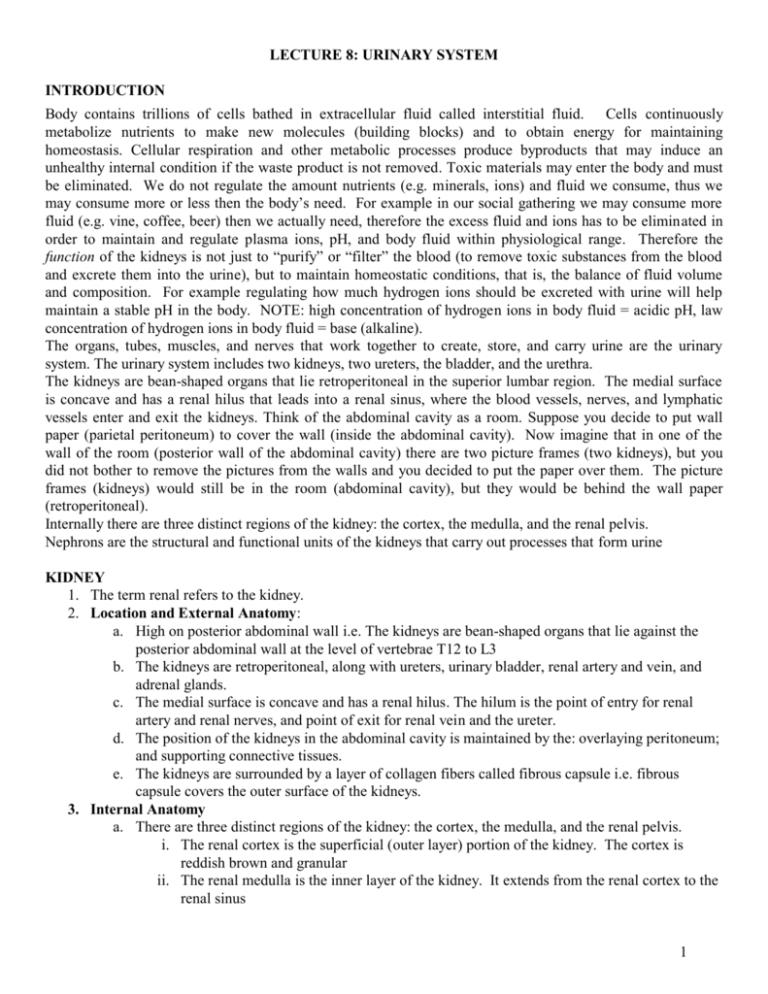
LECTURE 8: URINARY SYSTEM INTRODUCTION Body contains trillions of cells bathed in extracellular fluid called interstitial fluid. Cells continuously metabolize nutrients to make new molecules (building blocks) and to obtain energy for maintaining homeostasis. Cellular respiration and other metabolic processes produce byproducts that may induce an unhealthy internal condition if the waste product is not removed. Toxic materials may enter the body and must be eliminated. We do not regulate the amount nutrients (e.g. minerals, ions) and fluid we consume, thus we may consume more or less then the body’s need. For example in our social gathering we may consume more fluid (e.g. vine, coffee, beer) then we actually need, therefore the excess fluid and ions has to be eliminated in order to maintain and regulate plasma ions, pH, and body fluid within physiological range. Therefore the function of the kidneys is not just to “purify” or “filter” the blood (to remove toxic substances from the blood and excrete them into the urine), but to maintain homeostatic conditions, that is, the balance of fluid volume and composition. For example regulating how much hydrogen ions should be excreted with urine will help maintain a stable pH in the body. NOTE: high concentration of hydrogen ions in body fluid = acidic pH, law concentration of hydrogen ions in body fluid = base (alkaline). The organs, tubes, muscles, and nerves that work together to create, store, and carry urine are the urinary system. The urinary system includes two kidneys, two ureters, the bladder, and the urethra. The kidneys are bean-shaped organs that lie retroperitoneal in the superior lumbar region. The medial surface is concave and has a renal hilus that leads into a renal sinus, where the blood vessels, nerves, and lymphatic vessels enter and exit the kidneys. Think of the abdominal cavity as a room. Suppose you decide to put wall paper (parietal peritoneum) to cover the wall (inside the abdominal cavity). Now imagine that in one of the wall of the room (posterior wall of the abdominal cavity) there are two picture frames (two kidneys), but you did not bother to remove the pictures from the walls and you decided to put the paper over them. The picture frames (kidneys) would still be in the room (abdominal cavity), but they would be behind the wall paper (retroperitoneal). Internally there are three distinct regions of the kidney: the cortex, the medulla, and the renal pelvis. Nephrons are the structural and functional units of the kidneys that carry out processes that form urine KIDNEY 1. The term renal refers to the kidney. 2. Location and External Anatomy: a. High on posterior abdominal wall i.e. The kidneys are bean-shaped organs that lie against the posterior abdominal wall at the level of vertebrae T12 to L3 b. The kidneys are retroperitoneal, along with ureters, urinary bladder, renal artery and vein, and adrenal glands. c. The medial surface is concave and has a renal hilus. The hilum is the point of entry for renal artery and renal nerves, and point of exit for renal vein and the ureter. d. The position of the kidneys in the abdominal cavity is maintained by the: overlaying peritoneum; and supporting connective tissues. e. The kidneys are surrounded by a layer of collagen fibers called fibrous capsule i.e. fibrous capsule covers the outer surface of the kidneys. 3. Internal Anatomy a. There are three distinct regions of the kidney: the cortex, the medulla, and the renal pelvis. i. The renal cortex is the superficial (outer layer) portion of the kidney. The cortex is reddish brown and granular ii. The renal medulla is the inner layer of the kidney. It extends from the renal cortex to the renal sinus 1 1. Renal pyramids are conical structures found in the medulla. It extends from the renal cortex to a tip called renal papilla. 2. Renal column is a band of granular tissue that separate adjacent pyramids. iii. The renal pelvis is a large, funnel-shaped structure that collects urine from the major calyces. It continuous with the ureter i.e. it is the superior end of ureter which is expanded to form a funnel shape. b. Major and minor calyces collect urine and empty it into the renal pelvis. i. A minor calyx collects the urine produced by a single kidney lube (renal pyramid) ii. A major calyx forms when 2 or more than two minor calyces fuse together. FUNCTIONS OF KIDNEY 4. Although the primary role of the kidneys is excretion, they play more roles than are commonly realized. a. They filter blood plasma i.e. kidneys separate wastes from useful chemicals, and eliminate the wastes while the useful substance are reabsorbed and returned back to the blood. i. A waste is any substance that is useless or present in excess of the body’s needs; a metabolic waste is a waste substance produced by body processes; and nitrogenous wastes are among the most toxic. b. They regulate blood volume and pressure by eliminating or conserving water. c. They regulate the osmolarity of the body fluids by controlling the relative amounts of water and solutes. d. They secrete renin, an enzyme that activates hormonal mechanisms (renin angiotensin system) that control blood pressure and electrolyte balance (more specifically sodium concentration). e. They secrete erythropoietin, which stimulates production of RBCs. f. They collaborate with the lungs to regulate the concentration of CO 2 and the acid–base balance. g. They carry out the final step in synthesizing calcitriol and thereby contribute to calcium homeostasis. h. In conditions of extreme starvation, they carry out gluconeogenesis by deaminating amino acids; they excrete the amino group and ammonia and synthesize glucose from the rest of the molecule. 2 5. Summary a. Remove metabolic wastes and toxins from blood and excrete them to outside in urine. b. Maintenance of blood homeostasis: i. Regulation of RBC formation (hormone erythropoietin) ii. Blood pressure (enzyme renin) iii. Blood volume (hormone ADH) iv. Blood composition v. Synthesizing vitamin D vi. Regulate osmolarity of the body fluids vii. Blood pH by regulating retention or excretion of hydrogen ions BLOOD FLOW THROUGH KIDNEY 1. Blood supply into and out of the kidneys progresses to the cortex through renal arteries to segmental, lobar, interlobar, arcuate, cortical radiate arteries, afferent arteries, glomeruli, efferent arteries, and back to renal veins from cortical radiate, arcuate, and interlobar veins. a. Each kidney is supplied by a renal artery arising from the aorta. b. Just before or after entering the hilum, the renal artery divides into a few segmental arteries that then divide into a few interlobar arteries. c. An interlobar artery penetrates each renal column. d. It travels between the pyramids and long the way, it branches to form arcuate arteries e. Each arcuate artery gives rise to several interlobular (cortical radiate) arteries that pass upward into the cortex. f. A series of afferent arterioles arise from each interlobular artery. g. Each afferent arteriole supplies one functional unit of the kidney called a nephron i.e. each afferent artery enters the head of the nephron (functional unit of kidneys) called glomerular capsule of the nephron or corpuscle of the nephron. h. Inside the nephron the afferent arteriole leads to a ball of capillaries (network of capillaries) called a glomerulus i. Blood leaves the glomerulus by way of an efferent arteriole. 2. Summary Aorta → Renal Artery (to each kidney) → Segmental artery (as they enter the kidneys at hilus) → Interlobar arteries (between each pyramid) → Arcuate arteries (between medulla & cortex) → Interlobular arteries (within cortex) → Afferent arteriole (leading to glomerulus) → Glomerular capillaries (site of filtration) → Efferent arteriole (leading away from glomerulus) → Peritubular capillaries/vasa recta (around renal tubule) → Interlobular veins (within cortex) → Arcuate veins (between cortex and medulla) → Interlobar veins (between pyramids) → Renal vein (from each kidney) → Inferior vena cava 3 NEPHRON 1. Nephrons are the structural and functional units of the kidneys that carry out processes that form urine 2. Structure: Each nephron consists of a renal corpuscle and renal tubules a. Renal Corpuscle (head of the nephron) is composed of a network (knot) of capillaries called the glomerulus, a cover that surrounds the glomerulus called glomerular capsule (Bowman’s capsule) i.e. Bowman's capsule and the glomerulus make up the renal corpuscle of the nephron. i. Glomerulus is a knot of capillaries that lies within the renal corpuscle. b. The renal tubule begins at the glomerular capsule as the proximal convoluted tubule, continues through a hairpin loop, the loop of Henle, and turns into a distal convoluted tubule before emptying into a collecting duct. i. PCT is the portion of the nephron closest to the renal corpuscle 4 ii. DCT is the portion of the nephron that attaches to the collecting duct. iii. Loop of henle is the middle part c. The collecting ducts collect filtrate from many nephrons, and extend through the renal pyramid to the renal papilla, where they empty into a minor calyx. 3. There are two types of nephrons: about 85% are cortical nephrons, which are located almost entirely within the cortex; about 15% are juxtamedullary nephrons, located near the cortex-medulla junction i.e. about 85% of nephrons are found mostly in the cortex and are therefore termed “cortical nephrons” and about 15% of nephrons have a Loop of Henle that extend deep into the renal medulla and are therefore termed “juxtamedullary nephrons”. a. Juxtomedullary nephrons are very important in the production of concentrated urine at times of dehydration, as will be discussed later 4. The peritubular capillaries arise from efferent arterioles draining the glomerulus, and absorb solutes and water from the tubules. 5. The filtration membrane lies between the blood and the interior of the glomerular capsule, and allows free passage of water and solutes. 6. Summary a. Nephron = functional unit of kidney b. Nephron is composed of a renal corpuscle and a renal tubule. i. Renal Corpuscle = glomerulus (specialized capillaries which serve as filtration unit) 5 within Bowman's capsule. ii. Renal Tubule = proximal convoluted tubule (PCT); loop of henle; distal convoluted tubule (DCT) and collecting duct iii. Juxtaglomerular Apparatus (JGA) = point of contact between the afferent arteriole and distal convoluted tubule (DCT). 1. The JGA is very important in the regulation of glomerular filtration rate. URINE FORMATION The nephrons function to remove wastes from blood and regulate water and electrolyte concentrations. Urine is the end-product of these functions. Urine formation involves three major steps including: glomerular filtration; tubular reabsorption; and tubular secretion GROMERULAR FILTRATION 1. Glomerular filtration is a passive, nonselective process in which hydrostatic pressure forces fluids through the glomerular membrane. Because there is higher pressure inside the capillaries compared to the capsular space of the nephron, as blood flows, molecules and fluid are forced (pushed) from the area of high pressure (glomeruli) to area of low pressure (capsular space). a. The fenestrated glomerular capillaries filter water and dissolved materials (recall composition of blood: organic molecules such as glucose, amino acids, waste product such as urea, creatanin, uric acid, electrolytes, water) from blood. NOTE: the largest molecule that could pass through the pores of glomerular capillaries is protein albumin. i. This "filtrate" is collected in Bowman's Capsule. ii. Proteins are not filtered out of blood, because proteins are too large to be filtered. iii. Substances larger than albumin are normally not allowed to pass through the filtration membrane. 2. The net filtration pressure responsible for filtrate formation is given by the balance of glomerular hydrostatic pressure against the combined forces of colloid osmotic pressure of glomerular blood and capsular hydrostatic pressure exerted by the fluids in the glomerular capsule. a. Filtration is due to a force net filtration pressure (NFP) 6 i. Outward pressure called glomerular hydrostatic pressure (GHSP) inside glomerular capillaries i.e. this pressure pushes material out of the capillaries. ii. Inward in Bowman’s capsule iii. Net Filtration Pressure = outward pressure – inward pressure. Suppose outward pressure is 60 mmHg (millimeter of mercury = unit of pressure measurement), and inward pressure is 50 mmHg. The net filtration pressure would be 10mmHg. 3. The glomerular filtration rate (GFR) is the volume of filtrate formed each minute by all the glomeruli of the kidneys combined. a. Kidneys produce =125 ml fluid per minute b. Most of this is reabsorbed in proximal convoluted tubule (about 70% of this filtrate is reabsorbed by the proximal convoluted tube (PCT); and about 30% of this filtrate is reabsorbed by the loop of henle). 4. Maintenance of a relatively constant glomerular filtration rate is important because reabsorption of water and solutes depends on how quickly filtrate flows through the tubules. CONTROL OF GLOMERULAR FILTRATION RATE (GFR) 1. Normal GFR is approximately 125ml/minute (70 kg adult male, both kidneys) primarily due to glomerular hydrostatic pressure (GHSP). GFR remains relatively constant through two mechanisms, which include: a. Autoregulation by vasomotor center in medulla b. Renin-angiotensin system 2. Autoregulation (AR) by Vasomotor Center a. Under normal conditions, the parasympathetic autonomic nervous system (ANS) maintains AR through vasoconstriction of the afferent arteriole to decrease GFR when elevated or vasoconstriction of the efferent arteriole to increase GFR when low i. When glomerular filtration rate is high, the afferent arterioles are constricted, which means less blood flow to the glomeruli, and less blood flow means glomerular filtration rate will decrease; ii. When glomerular filtration rate if low, efferent arterioles are constricted, which means the flow of blood from glomeruli is delayed (because efferent arteriole is constricted and less blood exits the glomeruli), and this means more time for filtration = GFR increase b. AR can be overridden by the sympathetic ANS during significant volume loss or gain. A large blood volume loss, which markedly decreases blood pressure causes vasoconstriction of afferent arterioles, decreasing GFR, which decreases urine output to conserve water. A large blood volume gain, which markedly increases blood pressure causes vasodilation of afferent arterioles, increasing GFR, which increases urine output to eliminate the excess water. 3. Renin-Angiotensin System a. A decrease in blood volume (BV) causes a decrease in blood pressure (BP), which in turn decreases the glomerular hydrostatic pressure (GHSP) and decrease in GHSP will lead to decrease in net filtration pressure (the pressure difference between outward pressure and inward pressure), and decreased net filtration pressure means decreased GFR. b. When GFR is reduced, the amount of filtrate in the capsular space will also reduce. Receptors in the Juxtaglomerular Apparatus (JGA) detect this decrease and secrete an enzyme called renin. JGA detects this decrease in two ways: i. Baroreceptors in the JGA cells of the afferent arteriole detect a decrease in stretch and secrete the enzyme renin. ii. Chemoreceptors in the cells in the distal convoluted tubule (DCT) detect a decrease in the levels of sodium (Na+), potassium (K+), and chloride (Cl-), and further stimulate the 7 JGA cells to secrete the enzyme renin. c. In blood, renin converts the plasma protein, angiotensinogen to angiotensin I d. Primarily in the lungs where endothelial capillaries produce angiotensin converting enzyme (ACE), ACE converts angiotensin I to Angiotensin II. e. Angiotensin II targets four sites that work together to maintain sodium balance, water balance and blood pressure (which directly affects GFR). i. The efferent arterioles vasoconstrict, increasing GHSP, which directly increases GFR back to normal. 1. In response to a drop in overall blood pressure, angiotensin II stimulates constriction of the glomerular inlet and even greater constriction of the outlet ii. Angiotensin II stimulates the adrenal cortex to secrete aldosterone (a hormone). Aldosterone increases sodium (Na+) reabsorption at nephron tubules. Sodium retention means water retention because sodium is salt, so when sodium is retained (reabsorbed) water will follow it. This increases BV, which increases BP, which increases GHSP, and restores GFR back to normal. Aldosterone = promote sodium retention in the kidney iii. Angiotensin II stimulate the posterior pituitary gland to secrete antidiuretic hormone (ADH), which targets the collecting ducts (where under normal conditions water reabsorption does not occur), causing reabsorption H20. This increases BV, which increases BP, which increases GHSP, and restores GFR back to normal. ADH = less urine (more concentrated urine) iv. Angiotensin II stimulates the hypothalamus and triggers thirst, which increases fluid intake. This increases BV, which increases BP, which increases GHSP, and restores GFR back to normal. v. NOTE: when blood pressure is high Atrial natriuretic peptide are produced. Atrial natriuretic peptide will have the opposite effect of angiotensin II. For example increasing glomerular filtration rate, inhibiting renin and aldosterone secretion, 8 inhibiting the action of ADH on the kidney, inhibiting NaCl reabsorption by the collecting duct, decrease water reabsorption, inhibit thirst. TUBULAR REABSORPTION Tubular reabsorption is defined as the process by which substances are transported from the glomerular filtrate (through the walls of the renal tubule) back to the blood in the peritubular capillaries. Tubular reabsorption begins as soon as the filtrate enters the proximal convoluted tubule, and involves near total reabsorption of organic nutrients, and the hormonally regulated reabsorption of water and ions. Tubular reabsorption involves passive transport (facilitated diffusion, osmosis, diffusion) counter transport, co-transport, active transport. The most abundant cation of the filtrate is Na +, and reabsorption is always active. Passive tubular reabsorption is the passive reabsorption of negatively charged ions that travel along an electrical gradient created by the active reabsorption of Na+. Different areas of the tubules have different absorptive capabilities. The proximal convoluted tubule is most active in reabsorption, with most selective reabsorption occurring there. The descending limb of the loop of Henle is permeable to water, while the ascending limb is impermeable to water but permeable to electrolytes. The distal convoluted tubule and collecting duct have Na + and water permeability regulated by the hormones aldosterone, antidiuretic hormone, and atrial natriuretic peptide. Interplay between reserves in the bone, the rate of absorption, and the rate of excretion maintains calcium homeostasis. Calcium reabsorption by the kidneys is promoted by the hormone calcitriol. 1. About 70% occurs in the PCT and about 30% occur in loop of henle through the process of active transport and passive transport i.e. 99% of filtrate is reabsorbed back into the circulation. a. reabsorption of ions, organic molecules (glucose, amino acids), vitamins, and water occur at the PCT b. Reabsorption of water = osmosis c. Reabsorption of molecules = diffusion and active transport 2. Reabsorbed substances pass from the lumen of the renal tubule through the epithelial cells (PCT) and into the lumen of a peritubular capillary where they are returned to bloodstream. 3. Reabsorbed substances include: glucose; amino acids; water; ions (sodium, chloride, phosphate, sulfate, potassium); others (creatine, lactic acid. citric acid, urea, uric acid, ascorbic acid) 4. Substances that remain in filtrate become concentrated as water is reabsorbed. TUBULAR SECRETION Tubular secretion is the process by which substances are transported from the blood in the peritubular capilarries, and then from the peritubular capillaries to the DCT. Tubular secretion disposes (gets ride of) unwanted solutes, eliminates waste and solutes that were reabsorbed, rids the body of excess K+, and H+ (controls blood pH by regulating hydrogen excretion), removes toxins and drug. Tubular secretion is most active in the distal convoluted tubule, but occurs in the collecting ducts and distal convoluted tubules as well. 1. Tubular secretion maintains ion concentrations in blood (i.e. if the blood is high in K+, K+ will be secreted into urine and eliminated from the body) 2. Tubular secretion allows for secretion of metabolic wastes (urea, uric acid, and creatinin), toxin and drug. a. Urea constitutes approximately one-half of all nitrogenous waste. NOTE: recall from the previous lecture that ammonia (byproduct of protein metabolism) is converted to urea by the liver, because ammonia is very toxic, and urea is less toxic (no toxic). REGULATION OF URINE CONCENTRATION AND VOLUME 1. One of the critical functions of the kidney is to keep the solute load of body fluids constant by regulating urine concentration and volume. 9 2. The hormone anti-diuretic hormone (ADH) promotes the reabsorption of water through the DCT and collecting ducts, preventing excessive amounts of water from being lost in the urine. This negative feedback mechanism prevents dehydration. 3. ADH opens water channels (aquaporin) in DCT and CD that allows water to be resorbed by osmosis, due to the osmotic pressure set up by the juxtamedullary nephrons URINE COMPOSITION 1. Physical Characteristics a. Freshly voided urine is clear and pale to deep yellow due to urochrome, a pigment resulting from the destruction of hemoglobin. b. Fresh urine is slightly aromatic, but develops an ammonia odor if allowed to stand, due to bacterial metabolism of urea. c. Urine is usually slightly acidic (around pH 6) but can vary from about 4.5–8.0 in response to changes in metabolism or diet. d. Urine has a higher specific gravity than water, due to the presence of solutes. 2. Chemical Composition 3. Urine volume is about 95% water and 5% solutes, the largest solute fraction devoted to the nitrogenous wastes urea, creatinine, and uric acid, and other solutes (trace amount of amino acids, electrolytes, drugs, toxin) ELIMINATION OF URINE 1. Ureters are small tubes that carry urine from each kidney to the urinary bladder through peristaltic movements. a. The expanded end of the ureter forms the renal pelvis. 2. Urinary Bladder a. The urinary bladder is a muscular sac that expands as urine is produced by the kidneys to allow storage of urine until voiding is convenient. b. The wall of the bladder has three layers: an outer, a middle layer of (muscle), and an inner (mucosa) that is highly folded to allow distention of the bladder without a large increase in internal pressure c. Function: storage of urine 3. The Urethra a. The urethra is a muscular tube that drains urine from the body; it is 3–4 cm long in females, but closer to 20 cm in males. b. There are two sphincter muscles associated with the urethra: the internal urethral sphincter, which is involuntary and formed from detrusor muscle; and the external urethral sphincter, which is voluntary and formed by the skeletal muscle at the urogenital diaphragm 4. Micturition = the process by which urine is expelled from urinary bladder to outside a. Micturition reflex center is in sacral spinal cord. b. Parasympathetic cause detrusor muscle to contract in response to stretch of the urinary bladder. c. External urethra sphincter (skeletal muscle) is last “doorway” to pass, and therefore micturition can be (and usually is) inhibited until released by conscious control. SUMMARY OF THE FLOW OF FILTRATE FROM GLOMERULI TO URINE EXCRETION Starts at glomerulus where glomerular filtrate is collected in → Bowman's capsule → PCT (reabsorption) → loop of Henle (reabsorption) → DCT (reabsorption, final adjustment to composition of urine) → collecting duct (urine) → minor calyx → major calyx → renal pelvis → ureter (peristalsis) → urinary bladder (micturition) → urethra → outside 10 LIFE-SPAN CHANGES 1. As one ages, kidneys, ureters, and urethra changes occur, however nephrons are so numerous that the following changes are essentially masked. 2. The kidneys become grainy and scarred. 3. GFR decreases significantly as glomeruli atrophy, fill with connective tissue, or unwind. 4. Fat accumulates on the exterior of the renal tubules, making them asymmetric. a. Reabsorption and secretion become slow or impaired. 5. Finally, elasticity of urinary organs declines. a. Changes in urination patterns result. URINE FORMATION SUMMARY TABLE Major Step in Urine Formation glomerular filtration tubular reabsorption tubular secretion Location in Nephron glomerulus primarily through proximal convoluted tubule (PCT) primarily through distal convoluted tubule (DCT) Substances Transported and Mode of Transport All plasma constituents except proteins (i.e. glucose, amino acids, water, ions, creatine, lactic acid, urea, uric aid, ascorbic acid, etc) glucose, amino acids, water, ions, creatine, lactic acid, urea, uric acid, ascorbic acid, etc. excess ions, trace amino acids, urea, uric acid, drugs From where to where? (i.e. from blood to glomerular filtrate) from blood in glomerulus to “filtrate” in Bowman’s capsule from “filtrate” in PCT to blood in peritubular capillaries from blood in peritubular capillaries to “urine” in DCT 11

